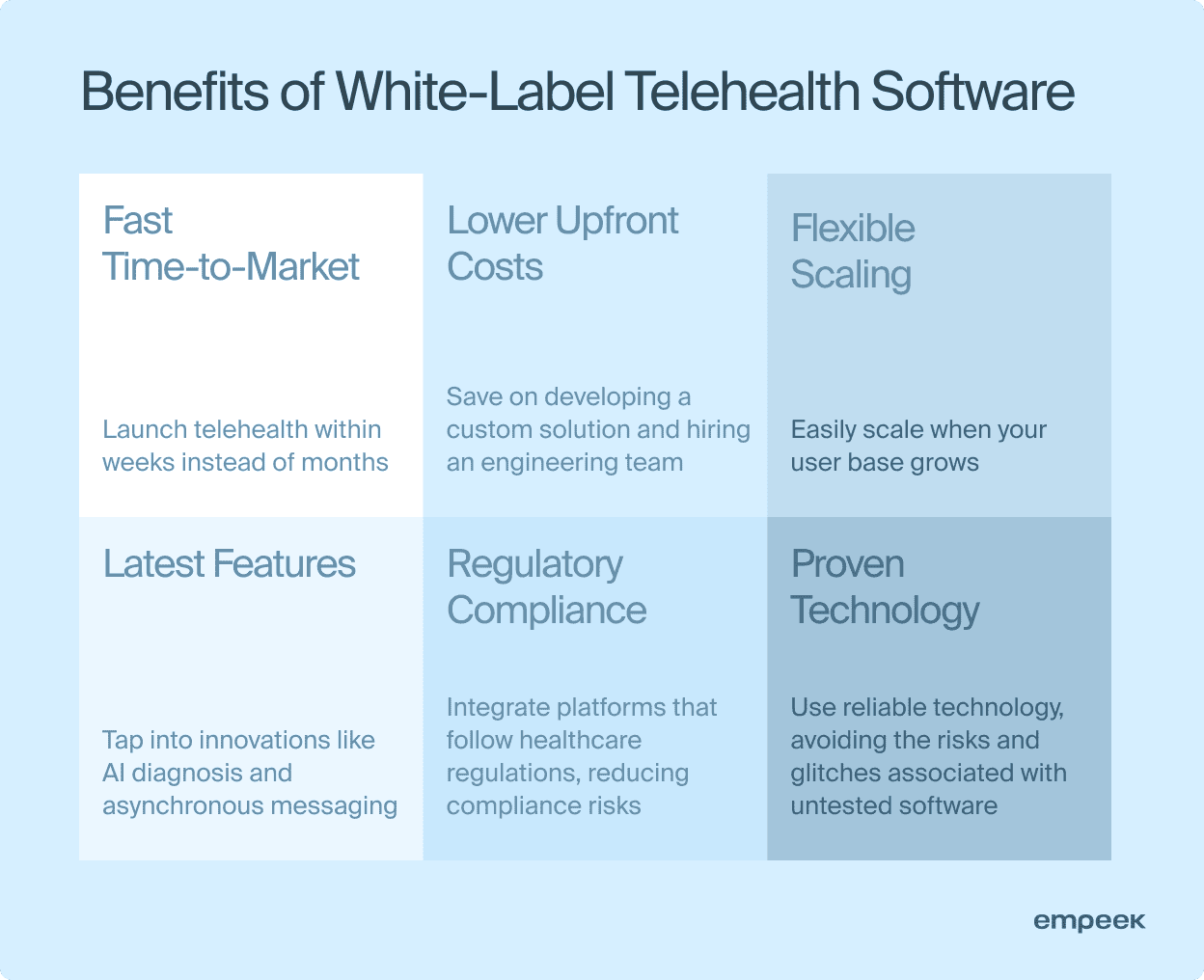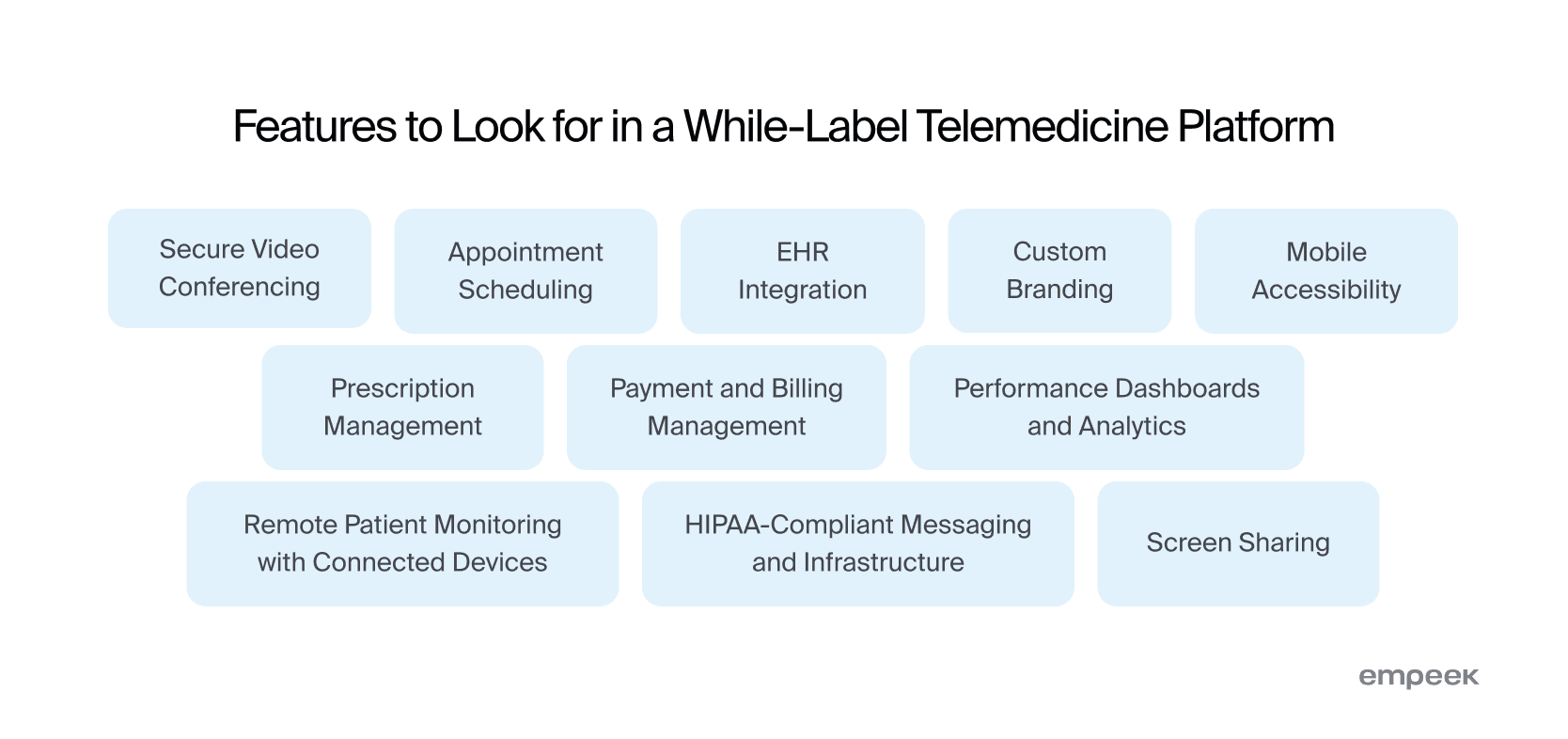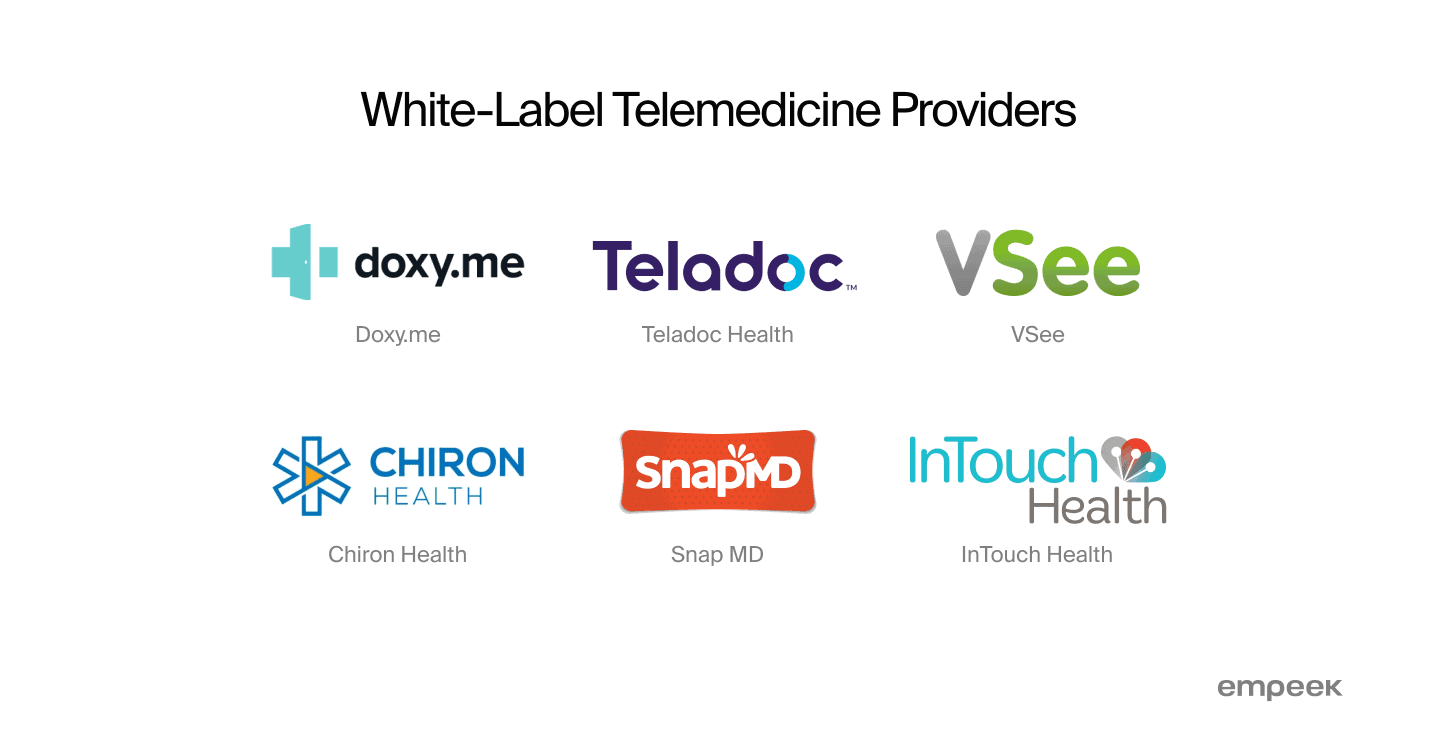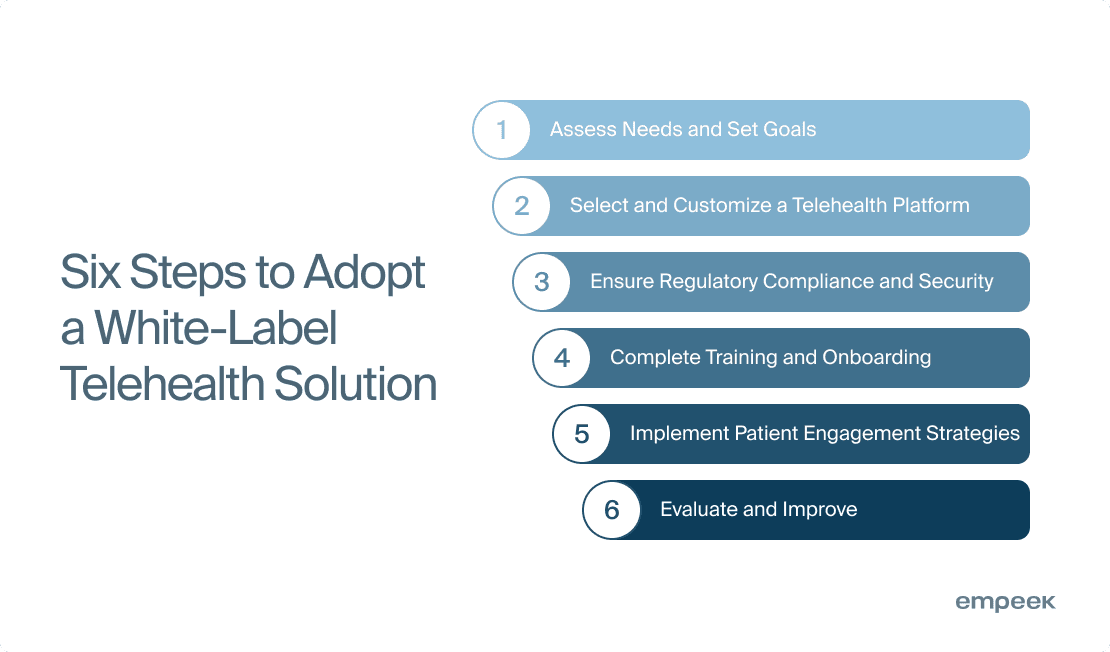White-label telemedicine has become a popular way for healthcare organizations to improve their medical software offerings. Instead of going through the lengthy and costly process of developing a custom solution from scratch, you can easily integrate a white-label app into your current setup. It’s a smart, cost-effective way to expand functionality and improve patient care.
Now, when picking out a white-label telemedicine app, you’ll want to keep an eye on how smoothly it integrates with your current systems, the level of customization it offers, and, of course, whether it ticks all the regulatory boxes.
Sometimes, though, a custom solution might be much more efficient than a white label — especially if you’ve got unique needs or a grand vision for your tech. Here, we’ll look at situations where a custom solution might be more beneficial than a white-label app. Read about this and other aspects of white-label telemedicine implementation in our post.
What is White-Label Telemedicine
White-label telemedicine is a customizable telehealth platform developed by a third-party provider, which healthcare organizations can rebrand and integrate into their existing systems as if it were their own. These solutions can be easily tailored to match a healthcare provider‘s brand, such as logos, colors, and special features, giving it a unique and exclusive appearance.
White-label telemedicine platforms typically come with a range of pre-built functionalities such as video conferencing, secure messaging, appointment scheduling, and patient management, which can be quickly deployed without extensive software development.

Things to Consider When Choosing a White-Label Telemedicine Platform
Choosing the right white-label telemedicine platform is a big deal, because it can shape how well you deliver care and how happy your patients are. If you’re a doctor aiming to broaden your services or a tech enthusiast diving into telehealth, finding the right platform is crucial.
As a healthcare professional, take a close look at the essential features you need. Can you customize the platform to fit your specific needs? Is it secure enough to protect patient information? And will it scale with your growing demands? These are all crucial points to consider.
To help you make this decision, we’ve put together some practical tips. Keep these in mind, and you’ll be on your way to choosing a platform that boosts both your efficiency and patient satisfaction.
Must-Have Functionality
First things first, it’s essential to understand the core functionalities that any robust white-label telemedicine solution must offer. The platform should deliver secure, high-quality video conferencing that’s not just crystal clear but also HIPAA-compliant, because patient privacy is non-negotiable. Also, they should easily integrate with your current EHR systems for smooth data management and interoperability.

Customization Options
When it comes to picking a healthcare platform, think of customization as your new best friend. A platform with extensive customization options lets you tweak everything from dashboards to workflows and forms, making your daily operations smoother and your patient care better.
Features like integration options, role-based access controls, and customized reporting are like adding perfect accessories that complete the look. With these tools, your platform will fit easily into your practice and adapt as you grow, helping you work smarter and provide even better care.
Scalability and Reliability
Scalability and reliability are critical factors when selecting the right platform for your business. As your operations expand, you need a platform to grow alongside you without glitches. So, ensure that any cloud-based solution you choose can effortlessly add users, locations, or new features.
Reliability, on the other hand, is all about keeping things running smoothly, even when you get busy. You don’t want something that throws a tantrum during your busiest times, so check for platforms with robust SLAs guaranteeing high availability and support. Ensure they have built-in redundancy and backup systems to minimize downtime and maintain service continuity.
If it can’t scale or stay reliable, it’s not worth your time.
Compliance and Security
Prioritize those platforms that comply with industry regulations, such as HIPAA, to safeguard patient data and ensure secure interactions. Look for platforms that go the extra mile with strong security measures—things like data encryption, secure logins, and thorough auditing systems. Ensure they protect data in transit and at rest and adhere to privacy standards to prevent unauthorized access. You want to make sure data is secure, whether it’s on the move or not. Also, don’t forget to double-check for encrypted video and messaging to keep patient information safe.
Your next read: Healthcare Software Compliance Guide: Key Regulations and Standards
User Experience
When picking a platform, you want something that’s easy to use for healthcare providers and patients—nobody wants to spend ages learning a complicated system. Go for one that’s intuitive, with simple navigation and workflows that make sense. Bonus points if you can customize it to fit your practice.
A good interface means providers can manage tasks easily, and patients benefit from straightforward scheduling, easy communication, and quick access to their health records. It’s even better if there’s in-app support to help with onboarding so everything runs flawlessly from the start.
Cost-Effectiveness
Now, let’s talk about cost. It’s important to find a platform that fits your budget but doesn’t skimp on the essentials. Balance the features offered with the cost of the telehealth platform. Make sure you’re getting the right features—like advanced reporting, seamless integration, and top-notch security—without breaking the bank. Evaluate the total cost of ownership, including implementation, training, and ongoing support, to ensure that you receive good value without sacrificing critical features or performance.
Top White-Label Telemedicine Platforms To Choose From
White-label solutions offer healthcare providers and organizations the flexibility to deliver branded virtual care experiences. Companies can tailor the user interface and features to match their unique brand identity and clinical workflows. These platforms provide a cost-effective way to quickly deploy telehealth services without investing in the development of proprietary technology. Here are six top white-label telemedicine platforms known for their features and customization options.

Doxy.me
Doxy.me is a go-to for healthcare providers who want a simple and effective telemedicine platform. It’s straightforward, making it easy for practices of any size to jump right in.
With features like HIPAA-compliant video calls, screen sharing, and appointment scheduling, it keeps things secure and user-friendly for healthcare professionals and patients.
White-Label Capabilities:
- Customizable waiting room with clinic logo and colors.
- Personalized domain for branded patient access links.
- Brandable email notifications and patient reminders.
Teladoc
Teladoc Health is like the all-in-one telemedicine solution. It covers a wide range of medical specialties, providing a solid virtual care platform that integrates smoothly with existing healthcare systems. Whether you’re a provider or patient, it’s designed to handle just about everything.
White-Label Capabilities:
- Customizable patient interface with clinic branding.
- API integration for embedding telehealth services into existing applications.
- White-label mobile app for iOS and Android.
VSee
VSee is another great option if you’re after HIPAA-compliant video conferencing. It’s suitable for healthcare organizations that need secure, scalable telehealth solutions. Plus, VSee is highly customizable, so you can adjust it to meet the specific needs of your organization.
White-Label Capabilities
- Brandable patient portal and scheduling interface.
- Customizable telemedicine workflows tailored to organizational requirements.
- API and SDK for integrating telehealth capabilities into third-party applications.
Chiron Health
Chiron Health offers a telemedicine platform which is all about boosting patient engagement and making practice management more efficient. It offers customizable features so you can tailor it to fit your practice’s specific needs and improve the overall patient experience.
White-Label Capabilities:
- Customizable patient intake forms and appointment reminders.
- Brandable telemedicine platform with clinic logo and colors.
- Integrated billing and payment solutions with customizable invoices.
SnapMD
SnapMD is a virtual care management platform designed for various telehealth services. You can use it for primary care, mental health therapy, chronic disease management, and even connect patients with specialists. It focuses on being scalable and compatible, perfect for healthcare providers looking to grow their telemedicine services.
White-Label Capabilities:
- Customizable patient portal and provider dashboard.
- Personalized telemedicine app with a brandable interface.
- API and SDK for seamless integration into existing healthcare IT infrastructure.
InTouch Health
InTouch Health is built for the big players—large healthcare systems and hospitals. Their enterprise-level telehealth platform lets them manage clinical workflows and patient care with ease, thanks to customizable features designed for complex operations.
White-Label Capabilities:
- Customizable virtual care workflows and patient engagement tools.
- Brandable telehealth app for healthcare providers and patients.
- API integration for interoperability with Electronic Health Records (EHR) and other healthcare systems.
These white-label telemedicine platforms come packed with a range of features that can be customized to meet the needs of different healthcare providers. They provide secure, efficient, and fully branded virtual care, ensuring a seamless experience for providers and patients.
If you want to connect a telemedicine platform with your current healthcare systems, our integration services have you covered. We’ll make sure data flows smoothly, making operations more efficient.
Need something more specific? No worries. We can build custom telehealth solutions tailored to meet the unique needs of your organization.
6 Steps of White-Label Telehealth Adoption Process
Adopting a white-label telehealth platform involves a systematic approach to ensure seamless integration and effective utilization within healthcare settings. Smooth implementation is critical to unlocking the real potential of telehealth, such as improved access to care and high patient engagement.
Here are the key steps of the white-label telehealth adoption process.

Needs Assessment and Goal Setting
Conduct a thorough needs assessment to pinpoint specific organizational objectives and challenges. Take a close look at your goals—whether it’s giving more patients access to care, improving how your team coordinates, or making operations run more smoothly. This step sets the foundation for everything that follows, so it’s important to get clear on your objectives right from the start.
Platform Selection and Customization
Choose a white-label telehealth platform that meets identified needs and aligns with organizational goals. You’ll want key features like secure video calls, integration with EHR systems, and mobile access so patients can use it on the go.
Make sure it’s easy for patients to book appointments, wait virtually, and communicate securely. This would improve their satisfaction and compliance with telemedicine sessions. You can even customize the platform with your branding to keep everything consistent for your patients.
Compliance and Regulatory Considerations
Now, don’t forget to check that the platform complies with regulations like HIPAA to keep patient data safe. Verify that the platform provider implements security measures such as encryption and access controls to protect sensitive information during telehealth sessions.
Training and Onboarding
Once you’ve got the right platform, provide thorough training for your staff. Make sure healthcare providers and administrative teams are comfortable with the platform, know how to navigate the workflows, and are familiar with best practices for virtual care. Good training helps everyone feel confident using the system.
Implementation of Patient Engagement and Adoption Strategies
To get patients on board, it’s important to educate them on the benefits of telehealth. Provide clear and simple resources—like FAQs, support options, and maybe even some incentives to try it out.
Personalized communication also goes a long way. By listening to patient feedback, integrating telehealth into your existing care models, and sharing success stories, you can build trust and encourage more people to adopt the service.
Evaluation and Continuous Improvement
Continuously evaluate the telehealth platform’s performance and impact on organizational objectives. Regularly gather feedback from both healthcare providers and patients to spot areas that could use a little fine-tuning. Use that input, along with new technology and changing healthcare needs, to make continuous improvements and keep the platform scalable and efficient.
In short, adopting a white-label telehealth platform is a process that needs careful planning to make sure everything integrates smoothly and works well. Before adding any new system, it’s important to analyze how well it functions and whether it’s compatible with what you already have. A solid plan helps you get the most out of the platform while avoiding any disruptions.
White-Label Telemedicine vs Custom Software Development
Custom-built telemedicine solutions are designed from scratch to meet specific needs, offering great flexibility but requiring significant time and resources. In contrast, white-label apps enable organizations to adopt ready-made virtual care solutions with minimal development effort. The primary distinction lies in the extent of customization and development investment.
For example, a telehealth startup may prefer custom development to integrate unique features tailored to a specialized healthcare niche. In contrast, a clinic seeking rapid entry into telemedicine may opt for a white-label app, enjoying a quicker launch and lower development expenses.
Choose white-label telemedicine if:
- You need to enter the telemedicine market quickly without extensive development time.
- Cost is always a big factor, so it’s smart to look for a solution that doesn’t require a huge initial investment in development.
- Basic telemedicine functionalities meet your current needs, and you prefer to focus on patient care rather than software customization.
- Compliance with healthcare regulations such as HIPAA is critical, and you prefer relying on a pre-certified solution.
- Scalability matters too—you need a platform that can grow as your patient base expands.
- You value simplicity and prefer a user-friendly interface that requires minimal training for staff and patients.
Choose custom software development if:
- Your organization has unique requirements off-the-shelf solutions cannot meet.
- You have specific needs for your niche, and you need a platform that offers features or integrations that fit those requirements.
- Your brand’s identity is really important so you want full control over the look & feel of the platform to ensure the patient experience aligns with your brand.
- You have the team and resources to manage a more complex system, including regular maintenance and updates.
- Data security is a top priority, and you want to make sure the platform meets all regulatory requirements so you can keep patient information safe at every step.
Empeek for Telemedicine Integration and Development
At Empeek, we specialize in telemedicine software integration and development for healthcare facilities. Our team works closely with every client to build telemedicine platforms that meet their unique organization’s needs.
We handle everything from start to finish – consulting, design, implementation, and ongoing support – so you can count on a reliable, high-quality platform every step of the way.
Check some of our projects below:
The Development of a Custom Remote Patient Monitoring Solution
The Empeek team created a solution that uses cellular and Wi-Fi technology to collect and transmit patient data from wearable devices to healthcare providers.
The goal? To improve patient care management, reduce unnecessary hospital visits, and reduce overall healthcare costs.
We designed a flexible platform compatible with various wearables, ensured top-notch data security, and integrated mobile apps to make accessing patient information a breeze. Read the full case study here.
Digital Mental Health Solution
We developed a digital mental health solution for the US-based company VelloHealth. This project was aimed at improving the efficiency of Assertive Community Treatment (ACT) teams. The software not only helps ACT teams stay safe and adhere to best practices but also integrates with electronic medical records, making it easier to streamline operations. Read the full case study here.
Schedule a consulting session to learn how we can help your medical business with our telemedicine integration and development services.
Conclusion
Choosing between a white-label telemedicine app and custom software development depends on the specific needs of your healthcare organization. White-label solutions are great for quick, cost-effective setup and offer basic telehealth features that can scale as you grow. Custom software, on the other hand, gives you complete control and the ability to design a platform that fits your unique needs. Understanding these differences will help you choose an optimum way to meet your organization’s goals with telemedicine software.








